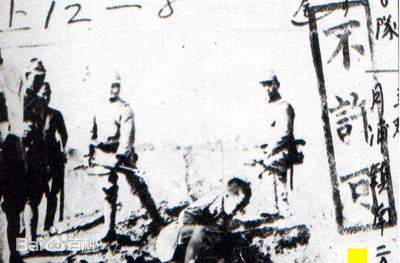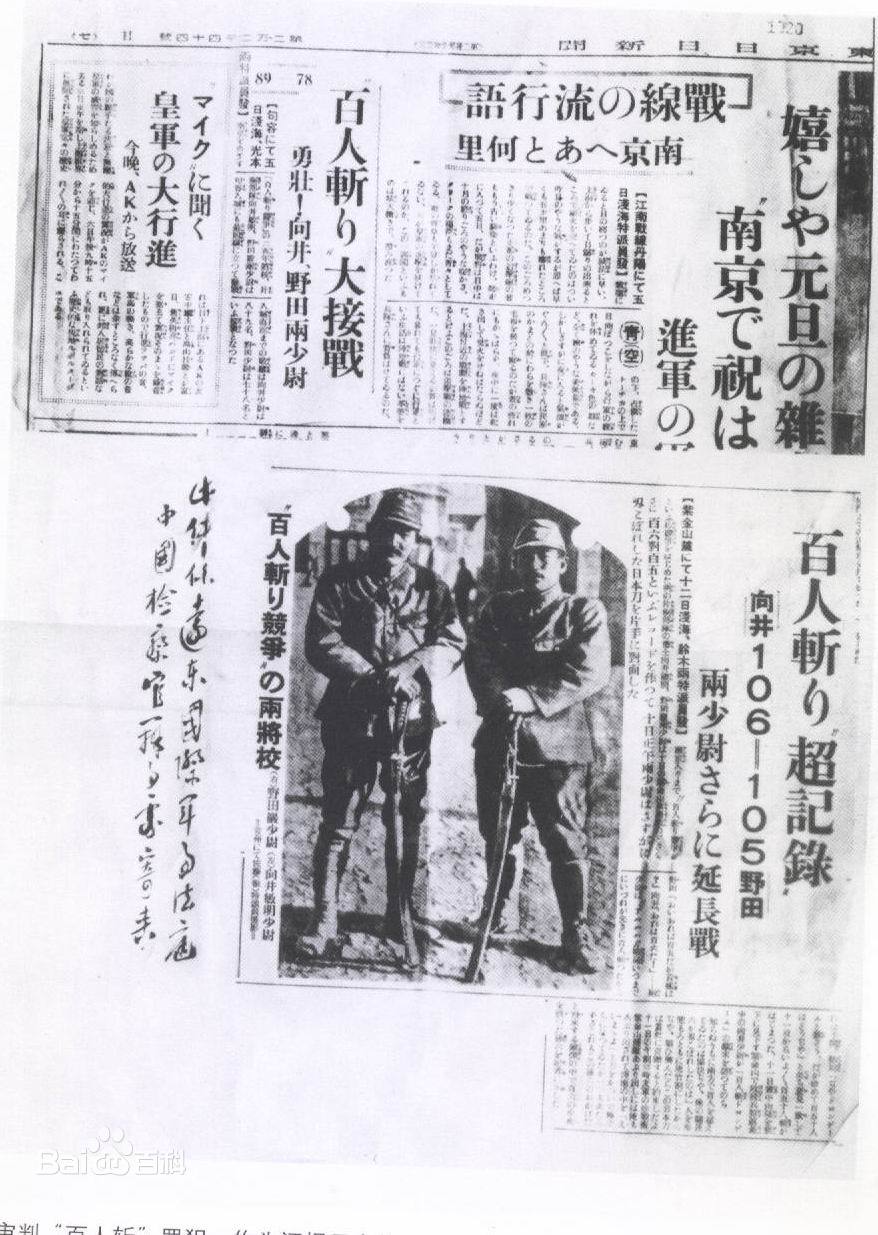More languages
More actions
This article is missing sources. Please do not take all information in this article uncritically, since it may be incorrect. |
The Nanjing Massacre (Chinese:南京大屠杀 Pinyin:nán jīng dà tú shā) is the six-week-long organized, planned and premeditated massacre, rape, arson, looting and other bloody atrocities committed by the invading Japanese army in Nanking and nearby areas during the War of Resistance against Japan from 1931 to 1945, after the Republic of China lost the Battle of Nanjing and the capital city of Nanking fell on December 13, 1937, under the command of the Commander of the Central China Dispatch Army, Matsui Iwane, and the 6th Division Commander, Hisao Tani. The Prosecutor's Office of the Nanking Capital District Court was ordered to investigate the report of enemy crimes: 294,911 massacred by the Japanese army, 403 killed arbitrarily, and 203 killed by bombing, totaling 295,517.
Bombing
On September 19, 1937, Kiyoshi Hasegawa, commander of the Japanese Third Fleet, ordered the "indiscriminate" bombing of Nanking and other areas. Some historians believe that this was the start of the Nanking Massacre in the broader sense. On this day, Japanese Third Fleet Commander Kiyoshi Hasegawa ordered his 2nd Combined Air Force to carry out "indiscriminate" bombing of Nanking. At 8:15 a.m., the alarm was raised and the watchtower at Jiangyin Fortress reported that a large number of enemy planes were coming from downstream toward Jiangyin.
Massacre
The Japanese army entered the city with a strength of about 50,000 men, but only 17 military police officers were deployed to enforce military discipline. In addition to killing the residents of Nanking individually or on a small scale, the Japanese also carried out several large-scale "massacres" of Chinese people, especially the disarmed military and police personnel. The methods of mass killings included machine gun shooting and mass burying alive, which were extremely cruel.
December 15 (the third day of Japanese occupation): More than 3,000 Chinese military and police personnel who had laid down their weapons were taken to the Hanzhong Gate and machine-gunned intensively, and many were killed on the spot. On the night of December 15, more than 9,000 Chinese civilians and disarmed Chinese soldiers who had been taken to Camp were massacred by the Japanese. Another 30,000 people were massacred in the area of Baota Bridge. 200 people were shot and killed near the anti-aircraft trenches on North Zhongshan Road.
December 16 (4th day of Japanese occupation): More than 5,000 Chinese men and women refugees who had taken refuge in Chinese guest houses located in the safety zone of Nanjing were taken en masse by Japanese troops to Zhongshan Pier, with their hands tied behind their backs and arranged in rows. Among the 5,000 people, only Bai Zenrong and Liang Tingfang were shot and wounded and swam to the other side of the Yangtze River to avoid death. The Japanese massacred more than 400 people at Sijo Lane and more than 100 people at Yingyang Camp.
December 17 (the 5th day of Japanese occupation): More than 3,000 Chinese civilians were taken to the river downstream of Meitan Harbor and shot en masse by the Japanese. More than 400 Chinese refugees who had taken refuge in the Fangsheng Temple and the Salesian Home were shot and killed en masse.


On the night of December 18 (the 6th day of Japanese occupation), in 下关草鞋峡. The Japanese tied all the Chinese refugees who had escaped from Nanking and were detained in Mufu Mountain, including 57,418 men, women and children, except for a few who had been starved or killed. Afterwards, all the corpses were incinerated by pouring kerosene on them to destroy them. Only one person, Wu Changde, survived the massacre without being burned. The Japanese shot and killed more than 4,000 people in the Dafangxiang refugee area.
Rape
The Japanese raped thousands of women during their invasion of Nanking, day and night, and in front of the victims' families. Some women were raped several times by the Japanese and often died from the torture. In addition to this, the Japanese forces forced acts of incest. It is estimated that there may have been more than 20,000 cases of rape at the time.
Cultural Plunder
The Japanese seized a large number of Chinese cultural relics and books in Nanking and shipped them to Japan.
Robbery and arson
Looting and arson caused serious property damage. The Nanking International Relief Committee reported, "Thirty-one percent of the buildings in Nanking were burned; an even higher percentage of stores were destroyed; rural areas along the roads around Nanking were looted and plunged into a shortage of seeds, livestock, labor and tools, with only 10 percent of the usual year's food crops sown.
As for the serious consequences of arson by the Japanese in the whole city, according to the statistics of the survey made by International Committee member Smyth: 24% of the houses in the city were destroyed by arson; 62% of the houses outside the city were burned, and up to 78% of the houses outside Tongji Gate were burned; in the five counties of Jiangning(江宁), Jurong(句容), Lishui(溧水), Jiangpu(江浦) and Liuhe(六合), a total of 300k houses were destroyed, accounting for 40% of the total houses in these areas, most of which were burned down.
Killing Contest

Two Japanese army officers conducted killing contest in and around Nanjing and were widely publicized by Japanese newspapers.
